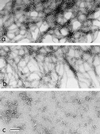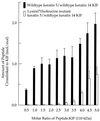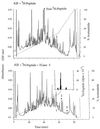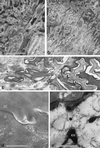A highly conserved lysine residue on the head domain of type II keratins is essential for the attachment of keratin intermediate filaments to the cornified cell envelope through isopeptide crosslinking by transglutaminases
- PMID: 9482839
- PMCID: PMC19251
- DOI: 10.1073/pnas.95.5.2067
A highly conserved lysine residue on the head domain of type II keratins is essential for the attachment of keratin intermediate filaments to the cornified cell envelope through isopeptide crosslinking by transglutaminases
Abstract
We have addressed the question of how keratin intermediate filaments are associated with the cell envelope at the periphery of cornified epidermal cells. Many peptides from human epidermal cell envelopes containing isopeptide crosslinks inserted by transglutaminases in vivo have been characterized. A major subset involves the type II keratin chains keratin 1, 2e, 5, or 6 crosslinked to several protein partners through a lysine residue located in a conserved region of the V1 subdomain of their head domains. This sequence specificity was confirmed in in vitro crosslinking experiments. Previously the causative mutation in a family with diffuse nonepidermolytic palmar-plantar keratoderma was shown to be the loss in one allele of the same lysine residue of the keratin 1 chain. Ultrastructural studies of affected palm epidermis have revealed abnormalities in the organization of keratin filaments subjacent to the cell envelope and in the shape of the cornified cells. Together, these data suggest a mechanism for the coordination of cornified cell structure by permanent covalent attachment of the keratin intermediate filament cytoskeleton to the cell envelope by transglutaminase crosslinking. Furthermore, these studies identify the essential role of a conserved lysine residue on the head domains of type II keratins in the supramolecular organization of keratin filaments in cells.
Figures





Similar articles
-
Conservation of the structure of keratin intermediate filaments: molecular mechanism by which different keratin molecules integrate into preexisting keratin intermediate filaments during differentiation.Biochemistry. 1993 Sep 28;32(38):10046-56. doi: 10.1021/bi00089a021. Biochemistry. 1993. PMID: 7691168
-
Making a connection: direct binding between keratin intermediate filaments and desmosomal proteins.J Cell Biol. 1994 Nov;127(4):1049-60. doi: 10.1083/jcb.127.4.1049. J Cell Biol. 1994. PMID: 7525601 Free PMC article.
-
Binding of keratin intermediate filaments (K10) to the cornified envelope in mouse epidermis: implications for barrier function.J Invest Dermatol. 1994 Dec;103(6):780-4. doi: 10.1111/1523-1747.ep12413024. J Invest Dermatol. 1994. PMID: 7528240
-
Lessons from disorders of epidermal differentiation-associated keratins.Histol Histopathol. 2002 Jan;17(1):331-8. doi: 10.14670/HH-17.331. Histol Histopathol. 2002. PMID: 11813882 Review.
-
Structural organization of cornified cell envelopes and alterations in inherited skin disorders.Exp Dermatol. 1998 Feb;7(1):1-10. doi: 10.1111/j.1600-0625.1998.tb00295.x. Exp Dermatol. 1998. PMID: 9517915 Review.
Cited by
-
Coiled-coil trigger motifs in the 1B and 2B rod domain segments are required for the stability of keratin intermediate filaments.Mol Biol Cell. 2000 Oct;11(10):3539-58. doi: 10.1091/mbc.11.10.3539. Mol Biol Cell. 2000. PMID: 11029054 Free PMC article.
-
De Novo Design of Proteins for Autocatalytic Isopeptide Bond Formation.J Am Chem Soc. 2025 Apr 9;147(14):12338-12346. doi: 10.1021/jacs.5c03319. Epub 2025 Mar 26. J Am Chem Soc. 2025. PMID: 40138671
-
Dexmedetomidine reduces in-hospital mortality in aneurysmal subarachnoid hemorrhage patients by modulating three key genes and inflammatory pathways: insights from clinical and bioinformatics analyses.Front Neurol. 2025 Jul 24;16:1554809. doi: 10.3389/fneur.2025.1554809. eCollection 2025. Front Neurol. 2025. PMID: 40777854 Free PMC article.
-
The tail domain is essential but the head domain dispensable for C. elegans intermediate filament IFA-2 function.PLoS One. 2015 Mar 5;10(3):e0119282. doi: 10.1371/journal.pone.0119282. eCollection 2015. PLoS One. 2015. PMID: 25742641 Free PMC article.
-
Formation of a normal epidermis supported by increased stability of keratins 5 and 14 in keratin 10 null mice.Mol Biol Cell. 2001 Jun;12(6):1557-68. doi: 10.1091/mbc.12.6.1557. Mol Biol Cell. 2001. PMID: 11408568 Free PMC article.
References
-
- Hohl D. Dermatologica. 1990;180:201–211. - PubMed
-
- Greenberg C S, Birckbichler P J, Rice R H. FASEB J. 1991;5:3071–3077. - PubMed
-
- Reichert U, Michel S, Schmidt R. In: Molecular Biology of the Skin. Darmon M, Blumenberg M, editors. New York: Academic; 1993. pp. 107–150.
-
- Holbrook K A, Wolff K. In: Dermatology in General Medicine. Fitzpatrick T B, Eisen A Z, Wolff K, Freedberg I M, Austen K F, editors. New York: McGraw–Hill; 1993. pp. 97–145.
-
- Elias P M. J Dermatol. 1996;23:756–758. - PubMed
MeSH terms
Substances
LinkOut - more resources
Full Text Sources
Other Literature Sources

